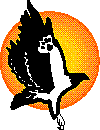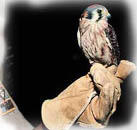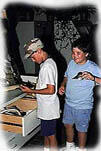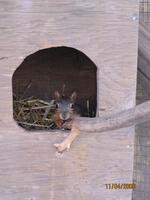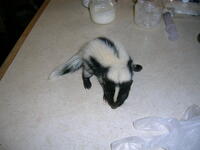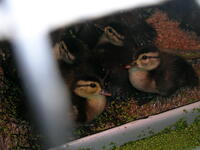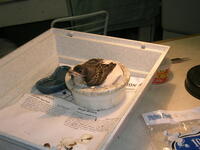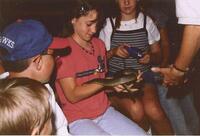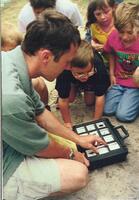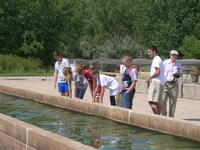Milford Nature Center

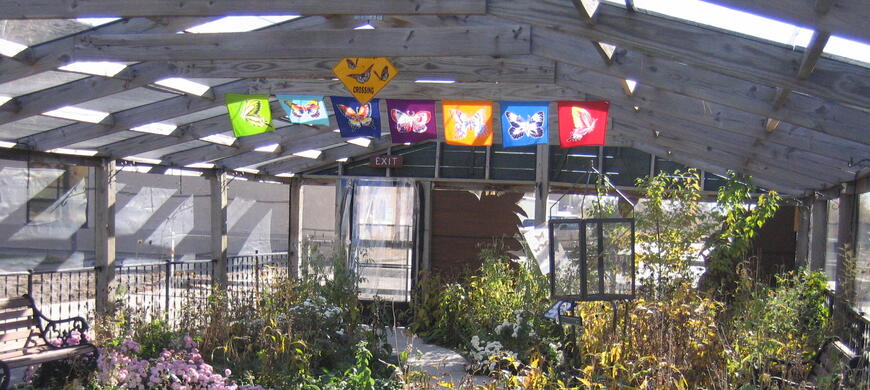
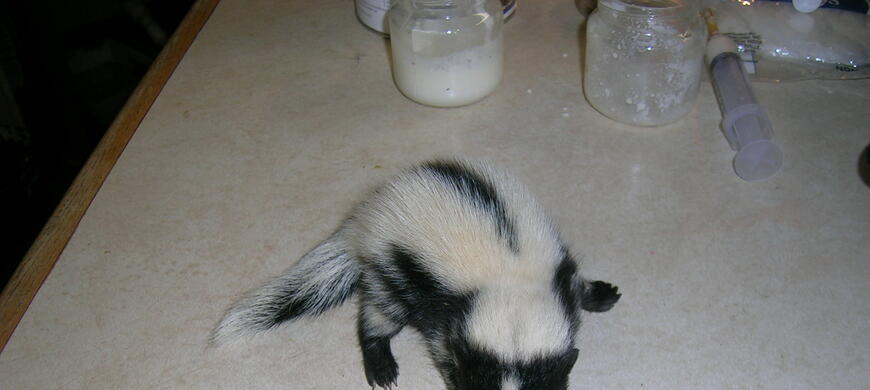
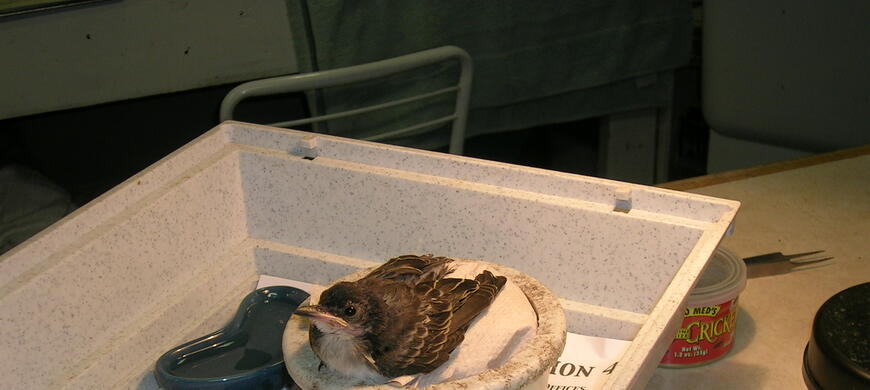

For information on the Kansas Eco-Meet, click here.
Located near beautiful Milford Reservoir in the Flint Hills of Kansas, the Milford Nature Center provides visitors with a better understanding of the natural communities of Kansas. At the center, visitors have the chance to see and touch native animal furs, print their own animals tracks, and use their sense of touch to identify natural mystery items. Dioramas line the halls, depicting an aquatic system with over 300 life-like fish, turtles, snakes, and insects and a terrestrial system showcasing wildlife from the prairies, marshes, and woods.
If you want to see living examples of Kansas wildlife, this is the place to visit! Live animal exhibits feature snakes, amphibians, turtles, lizards, prairie dogs, and many more. Outdoors is a large bird of prey exhibit featuring many native raptors including both a Bald Eagle and a Golden Eagle. Nature trails , the birdwatching wall, and a backyard habitat area can also be enjoyed on the center's grounds. The educational sites housed in these areas demonstrate how to attract birds, butterflies, and other animals to your backyard. The Butterfly House Exhibit is open from late May through early October (weather and butterflies permitting).
The Nature Playground is a favorite among visitors. This playground gives you a chance to slide through the belly of a snake or jump on the back of a spider. A picnic shelter can be found next to the playground area and is available on a first come, first serve basis.
Located adjacent to the nature center is the Milford Fish Hatchery . Visitors are welcome to walk around the outside raceways during their visit. Hatchery tours are available by appointment.
Admission is Free!
Hours:
- Monday - Friday: 9 am - 4:30 pm
- Third Thursdays, open from 9am - 6pm (Jan-Oct)
- Saturdays: 1 pm to 5 pm (April - Sept)
- Sundays: 1:00pm to 5:00pm (April - Sept)
- Closed weekends from October - March
- Groups can be accommodated by reservation only, by calling (785) 238-5323
Call (785) 238-LEAF (5323) for more information.
Milford Nature Center
3415 Hatchery Dr
Junction City, KS 66441
Use the form below to contact us
The Milford Nature Center is no longer offering Wildlife Rehabilitation Services for injured or orphaned animals. But, it is our intent to give an animal every opportunity to stay WILD. Please read the following information carefully and be absolutely sure the animal is in need of help. The best way to insure this is to call the nature center (785) 238-5323 or (785) 238-3108 during business hours with questions BEFORE you attempt to rescue the animal.
If you have found an orphaned wild animal:
Are you sure the creature is an orphan? Each year, hundreds of young wild animals are mistaken as orphans and turned over to rehabilitators for rearing. This happens most frequently to baby birds and to fawns. Over half of the fawns referred to wildlife rehabilitators are not orphans or injured, but "kidnapped" from their mothers. Here are some possibilities you may encounter:
Blown Down Nests
Bad weather can sometimes cause birds' nests to fall out of a tree. If you find a nest which has been blown down, but which has not been seriously damaged, place the nest (with the baby birds, eggs, or baby squirrels) back in the tree. If the nest has been damaged, place it in a small basket, such as a strawberry basket, and place it in the tree. If necessary, use twine to secure it.
If the baby bird is exceptionally young (has very little down), search for the nest and place the baby bird in it. If you are unable to locate the nest, contact a wildlife rehabilitator for instructions.
If the baby bird already has feathers and does not appear to be injured, leave it alone and keep an eye on it from a discreet distance. It is not unusual for baby birds to "fledge" from their nests before they have learned to fly. Watch for a parent attending the bird or foraging closeby. If the baby bird is in the street, place it under a nearby bush. If possible, lock up any lose dogs and cats for several hours. Do not handle the bird unnecessarily or remove it from the immediate area.
If, after several hours, no parent bird has tended the baby bird, contact a wildlife rehabilitator for advice.
If a wildlife rehabilitator advises you to bring the bird inside, keep it in a warm, dark, quiet spot. A shoe box lined with a folded towel works well. Be cautious giving the baby bird water; it can get fluid in its lungs. Do not attempt to feed it unless instructed by the wildlife rehabilitator. Never give any bird or wild animal cow's milk as it can make the animal sick. Some baby birds, such as song birds, cannot digest bread.
Follow the advise of the rehabilitator and take it to the rehabilitator as soon as possible.
Baby squirrels sometimes fall out of a nest that has been damaged in a storm or by an aggressive male squirrel. The squirrel may not be an orphan at all, but may have just fallen from its nest. If one squirrel has fallen from a damaged nest, others may have fallen out as well. Search the immediate area. Look under bushes and fallen leaves where other babies may have taken cover. You may warm the baby squirrel in your hands or by holding it close to your body and then place it at the base of the tree. Lock up any lose dogs and cats and keep watch, from a distance, for one to two hours. Given time, the mother will return and retrieve her baby. The scent of humans will not stop the mother from taking back her baby. If the weather is cold, line a box with some towels and a hot water bottle wrapped in a towel. Place the baby in the box and the box at the base of the tree.
If the mother squirrel has not returned for her young within two hours, you probably do have an orphan on your hands. Contact a wildlife rehabilitator. If the rehabilitator advises you to bring in the squirrel, place it in a cat carrier or a shoe box (with air holes poked through the top), lined with a folded towel.
It is not unusual for people to encounter young fawns whose mothers have left them "bedded down" while out foraging. If the fawn is not crying, is not being bitten by fire ants, its eyes are not swollen, and it has no visible wounds, leave it in peace. Any handling will only cause stress to the fawn. If the fawn is clearly sick or has been injured, contact a wildlife rehabilitator.
It is not true that birds or mammals will reject their young once they have been handled by humans. Nonetheless, the handling of wild babies should be avoided or kept to a minimum. Handling by humans can be stressful to the animal. Also, the human scent can sometimes attract predators seeking food.
It is not unusual for birds to fly head first into a window. Sometimes the blow will kill the bird, but other times it will only stun it. If, after hitting the window, a bird is alive but does not try to run away when you approach it and allows you to lift it gently in your cupped hands, it is probably in shock. If it is a warm day and the bird is in a yard where there are not any dogs, cats, or other predators, leave it alone. If the bird is in an area where it is vulnerable to predators, bring it indoors and place it in a brown grocery sack with the top folded closed or a box. Watch or check the bird frequently. Within a brief time, it should begin to move about and appear more alert. Once the bird shows signs of recovery, take it outdoors and release it.
If you have large plate glass windows and birds are frequently knocking themselves out, consider purchase a hawk silhouette to place on your window. This will discourage birds from flying directly towards your windows.
Click here for more information about wildlife rehabilitation and to locate a wildlife rehabber in Kansas.
The Milford Nature Center has two full-time staff and several part-time staff with over 40 years of combined interpretive experience. The staff believes in community and statewide involvement in efforts to promote conservation awareness and appreciation. As such, the staff is a member or currently serves on a committee for:
KACEE (Kansas Association for Conservation and Environmental Education)
National Association for Interpretation
National Wildlife Rehabilitators Association
National Association of American Falconers
Kansas ECO-Meets
Kansas Hawking Club
Geary County Convention and Visitor's Bureau
4-H Sportfishing Program
Flint Hills Audubon Society
Kansas Herpetological Society
Geary County Fish & Game Association
PAT SILOVSKY, Ed.D., DIRECTOR
The first director of the facility, Pat has been at the Nature Center since it began in 1989.
Pat holds a bachelor's and master's degree from Pittsburg State University and a doctorate of education from the University of Missouri, St. Louis. Pat has been a wildlife rehabilitator for close to 40 years. She has been awarded the 1996 Conservation Educator of the Year award from Kansas Wildlife Federation, Master Front Line Interpreter in 2010 from the National Association for Interpretation, and is the 2017 recipient of the John Stickler Award for Excellence in Conservation and Environmental Education given by the Kansas Association for Conservation and Environmental Education.
Katlin Dunsing, CIG, Assistant Director
Katlin is a graduate from Pittsburg State University with a Bachelors in Science of Communication and a Bachelors of Integrated Studies, emphasizing in Society, Sustainability and Resource Management. During her time at PSU, she worked with a range of different native species at Nature Reach and obtained her Certified Interpretive Guide certification. During her time in Wichita, KS, she went on to work as an Elementary Education Lead at Sedgwick County Zoo, and eventually the love of Kansas flora and fauna brought her to Great Plains Nature Center where she served with KDWP as a 999 Seasonal and moved on to be their Lead Naturalist. She took the position of the Assistant Director at Milford Nature Center in 2023! She is an active member of KACEE and NAI and is passionate about providing engaging and inclusive interpretation for all ages.
Education the "Natural" Way
The staff of the Milford Nature Center invites teachers and youth group leaders to join us for our engaging selection of hands-on lessons in natural science. We provide opportunities for children to discover and experience the natural world. Through this process, we believe children will begin developing a knowledge and appreciation of nature that will endure throughout their lives.
Program Information
All programs are planned to take from 30 to 90 minutes, are free of charge, and will use live animals, plants, or other hands-on material.
Age recommendations
While nearly all our standard programs can be enjoyed by all age groups, we have found that some are well-suited to younger or older audiences. The following age recommendations are for your use as a guide when selecting a program.
Need a program developed?
Is your group studying a topic not covered by the programs on this page? We can develop programs on other topics on request. Call for more information.
How to schedule a program
To schedule a program, please call us at (785) 238-LEAF, Monday through Friday between 8:30 am and 4:30 pm or email us. Please call at least two weeks prior to your desired program date. One month or more advanced scheduling may be required for dates in the spring. Many, but not all, of the education programs can be brought to your facility. The best months for outreach are October through March but outreach programs are available throughout the year.
Pre-K to 3rd
Have Seeds, Will Travel(30 min., fall only, Pre-K to 2nd)
Your class will learn some basics about plants and seeds in this outdoor activity as they test different methods of seed dispersal.
Animal Architects(45 min., any season, max# 30, Pre-K to 3rd)
Your group will discover the amazing variety of animal homes and try to create their own animal home outdoors.
Sensory Hike(45 min., spring-fall, max # 25, Pre-K to 2nd)
This activity will tune your students "in" to their senses to help them discover the outdoor world.
Animal Babies(30 min., spring, K to 3rd)
This program combines animal mounts, a video, and live animals to help children understand young animals and how they relate to their parents.
Also available.... Life Cycles
Peepers, Leapers, & Creepers(45 min., any season, 2nd to 4th)
Live animals and various hands-on materials are used to teach children how to classify animals as reptiles or amphibians.
Insects Investigations(45 min., summer-fall, max # 30, 1st to 3rd)
Many plants are pollinated by butterflies. Children will learn about this important interaction as they catch and observe live butterflies.
4th and Above
Fill the Bill(60 min., any season, max # 30, 3rd to 5th)
This program is for the birds! Children will use hands on materials to understand the adaptations birds have to aid in their survival.
Habitat Walk(45 min., spring-fall, max # 30, 3rd to 5th)
Every animal has a habitat. Children will learn what a habitat is and compare the kinds of life in different habitats on our nature trail.
Environmental Forensics(90 min., any season, max # 20, 4th to 6th)
Can your students solve the “Mystery of the Lifeless Wildlife"? Some ill-doer is wreaking havoc on our nature trail! Your students will follow the clues to solve the mystery. This program may have limited availability due to staff availability.
Water We Have Here? (90 min., spring-fall, max. #30, 5th to 7th)
Explore the aquatic life found around the Nature Center by collecting animals and using various methods to compare different aquatic habitats.
Prairie Animals(45 min., any season, 4th to H.S.)
Live animals and various animal artifacts will introduce audiences to some native prairie wildlife and their favorite habitat. This program is also popular with residents of nursing homes, who are often prompted to reminisce about the "good-ol' days".
Kansas Vertebrates(60 min., any season, 5th to H.S.)
Live animals will be used to introduce the concepts of animal classification and adaptation.
Orienteering(60 min., spring/fall, max. #30, 6th to Adults)
After learning a few basic orienteering skills, participants will use a compass to complete an outdoor scavenger hunt on the Nature Center grounds.
Jurassic Rocks(45 min., any season, 5th to Adults)
Audiences will have a chance to get their hands on some Kansas fossils and learn what our state would have been like millions of years ago.
Team Challenge(45 min., any season, max # 25, 6th to Senior Citizens)
Your group will learn teamwork as they try to solve a series of puzzles. Dress in comfortable exercise clothes for this outdoor activity.
The "Unhuggables"(45 min., any season, all ages)
There are some animals that have few admirers yet help us in ways we do not always recognize. This live animal program will help viewers understand a few of them, and perhaps overcome their fear of some of nature's critters!
Also available ... Bats and/or Spiders
Birds of Prey(45 min., any season, all ages)
Live residents of the Nature Center such as a Red-tailed Hawk, American Kestrel, or maybe even a Turkey Vulture will engage your students as they learn about these fascinating animals first-hand.
Also available ... Nightime Diners: Owls. Learn more about the amazing skills of owls in this live animal presentation featuring several common Kansas owl species.
The Snake's Tale(45 min., any season, all ages)
What better way to get to know these often-misunderstood creatures then with hands-on experience? Let one of our naturalists introduce your group to several species of common Kansas snakes.
Scavenger Hunt(30 min., any season)
These indoor and/or outdoor scavenger hunts will familiarize students with the Nature Center and Tallgrass Trail.
Kansas Symbols(45 min., any season)
Meet the different "natural" symbols of Kansas. Learn about bison, the meadowlark, the sunflower, the honeybee, the cottonwood tree, the box turtle, and the tiger salamander. This program is great for Kansas Day celebrations.
Field Trip Considerations
Arrival
We have certain guidelines in place during the COVID-19 pandemic. Please call us for the most recent information about those guidelines.
It is especially important that you arrive on time. We suggest arriving 10 minutes before the start of your program to unload the students, take restroom breaks as needed, and bring them inside.
Picnic Area/Playground
There is a picnic shelter and playground area for use by groups at the Nature Center. The shelter houses 10 picnic tables that can easily seat about 8 to the table, more if necessary. The shelter cannot be reserved but is available on a first come, first serve basis. Grilling is not allowed unless prior permission is obtained. Many other picnic areas can be found nearby, and we will happily give direction to another nearby site.
The playground area has a nature theme and is adjacent to the shelter. Students can jump on the back of a spider, climb through a spider's web, slide through the "insides" of a snake, or walk on a centipede while visiting the playground. There is also a sandbox and concrete animal structures to climb on.
There is a pop machine located outside the Nature Center. Soda and water selections are $2.50 for a 20 oz. bottle.
Nature Center Gift Shop
There is a small gift shop at the Nature Center with a variety of nature-related items for sale. You may wish to notify your students in advance if they will be allowed to make purchases.
Accessibility
The Milford Nature Center and Fish Hatchery are wheelchair accessible. The walking paths and playground are woodchipped surfaces. Please notify us of any special needs at the time of scheduling.
Self-Guided Visits
Self-guided visits enable teachers to take advantage of our site and facilities even when Nature Center staff are not available. Advance notification is required when groups are wishing to take a self-guided tour.
A number of kits are available for educators to check out for use in the classroom. The boxes contain a variety of hands-on materials, activities, and resource materials. Materials must be checked out and returned to the Nature Center. We do not ship boxes to schools.
Titles include:
Insects
Kansas Symbols
Trees and Plants
Wetlands
Endangered Species.
This is a Cargo for Conservation kit from the U.S. Fish & Wildlife Service
Kansas Skins and Skulls.
This box includes skins of common mammals in Kansas such as coyote, bobcat, striped skunk, red fox, racoon, opossum, and beaver. The kit also includes skulls of the beaver, coyote, and racoon. Additional skins and skulls may be requested.
Classroom
ECO - Meet
Volunteers
Mother's Day Wildflower Sale
Join us for the 2024 Mother's Day Plant Sale! on May 12th from 1-5pm we will have a wildflower sale, crafts, DIY seed balls and native plant seminars. These will run at 2pm, 3pm, and 4pm. This is a free event and profits from the wildflower sale directly help benefit the Friends of the Milford Nature Center which funds our Butterfly Garden!
Third Thursdays
Third Thursdays are back! At 6pm on the third Thursday of every month, we will hold a free program for all ages on a different topic. The program will take place in the Starbird Building that is across from the nature center. Milford Nature Center will be open from 9-6pm on the days of Third Thursdays!










